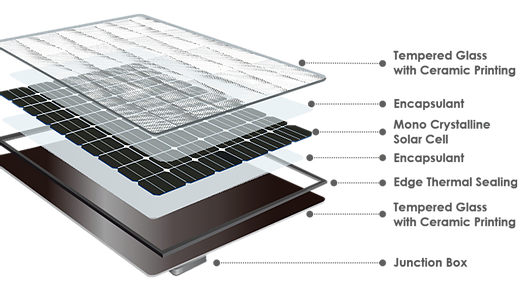We have been shamelessly ignoring the energy transition here at proptechaday. Mostly because there are so many other interesting proptech companies competing for our attention, but also in part because the novelty of a lot of green energy technologies got lost over time and what left is steadily maturing industries focused on cost, efficiency, and scale. All important attributes, no doubt, but less enticing nevertheless. A good example of this dynamic is solar power. Invented in the 1950’s, capturing the imagination in the 1960’s while used in space, and then losing it again while steadily improving in efficiency and declining in price. But the challenge that still remains is getting solar panels deployed as widely as possible, and that’s where HeliArtec comes in.
👽 What?
HeliArtec produces photovoltaic cells that can be used as a building envelope. The difference with traditional solar cells is that they are embedded in an enclosure of printed toughened glass. The combination of a robust hull, PV panels, and digital ceramic printing that can be produced in any size allows the panels to be used as facade in a wide range of architectural designs.
imagery courtesy HeliArtec
The panels come in a wide range of styles mimicking traditional building materials, but can also be custom printed depending on the requirements of the client. In any case, it results in an aesthetically pleasing way to generate additional green energy.
👍 Why
This solution unlocks a huge potential in additional reach for generating solar energy. Not only is the facade traditionally larger in area than the roof, but it also opens up possibilities for the use of solar panels where they are currently not permitted due to zoning rules or aesthetic objections.
Building-integrated photovoltaics facilitate a viable route for high-density buildings, even with limited roof area, to become zero energy buildings.
👎 Why not?
Of course, the prints do reduce the output of the solar panels, but this effect is less impactful than one might suspect and is dependent on the brightness of the print.
Solar facades are more expensive to install than other types of facades, but if you take into account the payback effects can provide an economically viable alternative.
🤷 Who?
HeliArtec was founded in 05/2017 in Taiwan by Ting-Hui Huang, who currently acts as CEO. In 2018 they participated in the PV opMaat project. They officially launched at the beginning of 2019 and later that year secured funding from Taiwan’s National Development Fund. In 2020 HeliArtec won a Red Dot award in the category best of the best.
🕵️♀️ Who else?
There are a lot of competitors that offer photovoltaics that integrates into your architecture, most even customizable in a specific color. Avancis, Nice Solar Energy, Issol, Saint-gobain, Reynaers and Glassbel all provide building-integrated solutions. Unlike the solution Heliartic these solutions mostly still have the look-and-feel of traditional solar panels that are mounted onto the facade.
Solablock offers a photovoltaic brick providing vertical, masonry-backed solar.
Studio Solarix incorporates dots into the fabric of the PV-panels to add texture into the design.
The aptly named Kameleon solar also offers custom ceramic printed panels under the ColorBlast brand.
📚 Further reading?
Solar Skins: An opportunity for greener cities
✨ Things happening
Proptech predictions galore in the first week of 2021… Glenn Felson wrote an interesting article on the need for residential real estate agents… The propcast is back with season 4…



